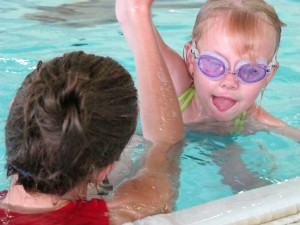Parents lean toward swimming lessons as number of drownings rise
By Renée Rodgers

TRENTON, On. (24/06/11) Madison Jaenicke, 6, practices staying afloat with her instructor Brianna Christopher at the Quinte West YMCA. Photo by Renee Rodgers.
Nina Jaenicke from Brighton knows more small children are drowning in Canada and she isn’t taking chances with her little ones.
She enrolled her daughter Madison Jaenicke, 6, in swimming lessons at the Quinte West YMCA so she would learn the basics of how to swim. She plans on enrolling her younger child soon.
“My reasoning behind it is to try to keep them safer,” Nina said. “If they’re equipped with those skills, to know how to swim or even just general water safety, that’s pretty important to us. Not that they’re exposed to water when we’re not there but on the chance something happens, they’ll know what to do.”
Twenty-two children under five drowned in Canada last year according to interim data in a new report from the Canadian Lifesaving Society. That’s up from 14 the year before.
Of these 22 deaths, 13 were in Ontario, said Barbara Byers, Toronto’s public education director for the society.
The 13 deaths represent a 260 per cent increase in Ontario from the year before according to a report released this month by Ontario’s chief coroner.
Byers stressed the importance of constantly supervising children around water and staying within a few feet at all times.
“Most people are surprised to hear that drowning can happen in 20 seconds – and it’s silent,” she said. “If you think you will be able to hear and see your child if you turn around and barbeque lunch or answer a cell-phone or scoot in the house for a minute, you’re wrong.”
Young children often drown in backyard pools, said Joanna Mestre, a health promoter at the Hastings-Prince Edward Health Unit. Mestre said pools should be closed off, to prevent accidents from happening.
“If backyard pools have four-sided fencing and self-latching, self-locking gates, it provides a barrier to the water hazard,” she said. “In the scenario where a parent may briefly lost track of a little one, it buys them a few seconds of safety.”
Tiffany Ward, aquatics supervisor for the Quinte West YMCA, said it generally takes about three lessons for a child to learn swimming basics.
Most young children, she said, are eager to be in the water.
“They’re excited to be with their instructors,” she said. “They’re excited about their lessons and to be with their friends. We do get the few children that are a little nervous, that maybe haven’t been around the water as much. We work with them one on one.”
New Canadians are another group at an increased risk of drowning. A study conducted last year by the Lifesaving Society showed new Canadians are four times more likely to be unable to swim than those born here.
“Many new Canadians come from countries where water safety and learning to swim is just not part of their experience,” said Byers. “They may live in countries that are landlocked or just don’t have a lot of opportunity, don’t have pools, don’t have the lakes that we have here.”
 Print This Post
Print This Post






